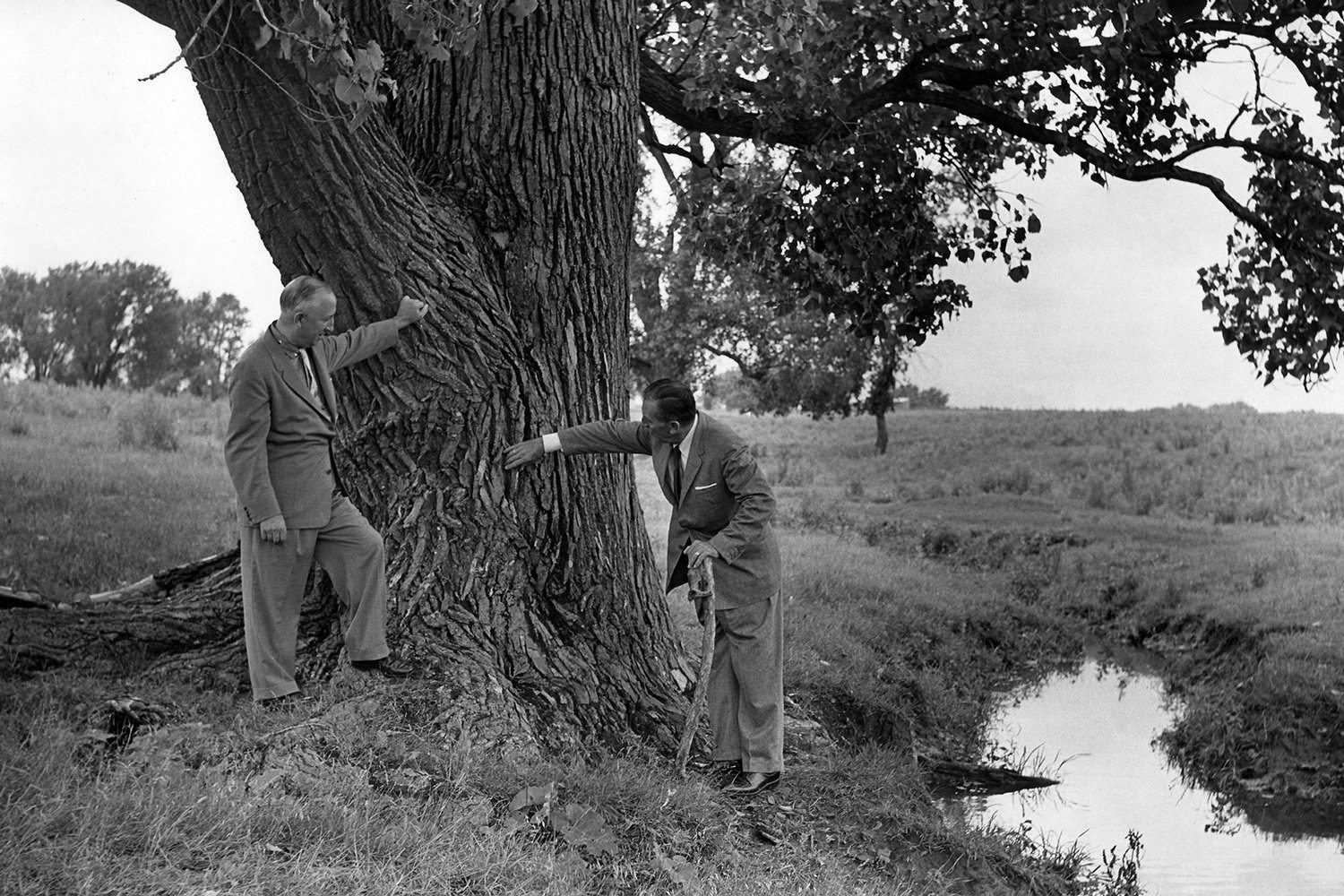Jim Scaggs was driving to work in Iron County one day this year when he spotted a feral hog in the road. He couldn’t react fast enough to avoid this one—thud—and ran into it.
Scaggs considered this as decidedly worse than a common car-animal accident, not so much because of the damage but because of what it symbolized about the feral hog invasion of southern Missouri.
Scaggs is the presiding commissioner of Iron County and a farm owner, so he was already intimately familiar with the explosion in the feral hog population across the southern portion of the state. They have repeatedly torn up his farm and farms owned by his neighbors and friends. He considered seeing hogs on the road as evidence of an escalation of an already serious problem.
Missouri’s feral hog problem started in the mid 1990s, when misguided hunters apparently released hogs in order to hunt them, according to state officials. Over the years, the hog population exploded. A pig can start breeding at about six months old and have a litter 114 days later. That means a sow born in April can have babies by the end of the year. Average litters typically include five or six piglets, meaning the growth rate can be as high as 166 percent per year.
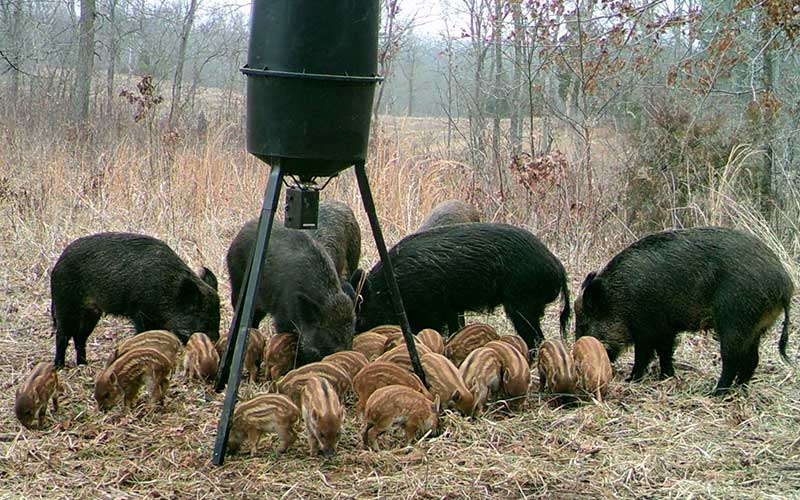
With the rise in feral hog population has come a rise in damage to farmlands and woodland areas. Ten years ago, the USDA estimated fixing the damage feral hogs cause and trying to control their population cost $1.5 billion nationally; that number has surely grown in the time since.
The feral hogs’ rooting (eating the grass and digging with their noses to eat whatever else is in the soil) and wallowing (rolling on the ground/in the mud) lead to soil erosion, reduced water quality, and ruined crops and hay fields. The hogs also destroy glades, fens, and springs.
What had been an issue confined to farms and forests has been creeping closer to civilization for the last few years. Scaggs led prospective business owners on a tour of possible building sites, including some abandoned properties in his county. “They were destroyed with hogs,” he said. “I’m sure the absentee landowners who are out of state don’t even know the property is that way.”
Scaggs owns more than 100 acres in Iron County on which he raises cattle and grows hay. He farms as a hobby. He has had to re-sow one pasture three times due to hog damage. At $30 an acre just for seed—not counting time or equipment or anything else—that’s an expensive hobby. Scaggs and other farmers can’t afford to keep paying for hog damage.
Across 30 southern Missouri counties, farmers, property owners, conservationists, and government officials are sounding similar alarms. Feral hogs, once a nuisance, have grown far beyond that.

The feral hog infestation is not the only invasive species problem the state is facing, but it is the most prominent and is the conservation department’s top priority. Other invasive species targeted include carp, Asian long-horned beetles, and emerald ash borers (an exotic beetle that kills ash trees.)
“Battling invasive species, especially [one] as costly and destructive to private lands and our natural resources as feral hogs are, is a battle that is worth fighting,” said Mark McLain, feral hog elimination team leader with the Missouri Department of Conservation.
McLain has worked in the Piedmont area in various roles in the conservation department for 19 years. Through that time, he has seen feral hogs grow from a minor nuisance to a burgeoning problem that threatens every aspect of wildlife, from fish to rodents to birds, water to grass to trees.
One day last spring, he examined the damage feral hogs are doing and the traps the MDC is using to get rid of them.
He stopped his truck high atop a hill. He looked left, to a grassy field between his truck and a small lake, maybe half a mile away. The field was a dull gray-green, as spring growth had not started yet. Here and there were splotches of even duller gray, like they were dark because of shadows cast by clouds, only it was a clear day.
That was evidence, McLain said, of feral hogs killing the grass by “rooting” it. The grass and other items in the soil, such as bugs, worms, and acorns, would have fed deer, rodents, and other native animals. Now those creatures would have to find food elsewhere.
McLain took his foot off the brake and coasted down the hill. He suddenly jerked the truck to a stop. “Look at that,” he said, pointing to a spot just a few feet from the road. It looked like someone had played with a pogo stick in the dirt.
It was more evidence of feral hogs rooting. McLain had driven this stretch of road three days earlier on the way back from a trap, and this rooting was not there then. That meant the damage was fresh.
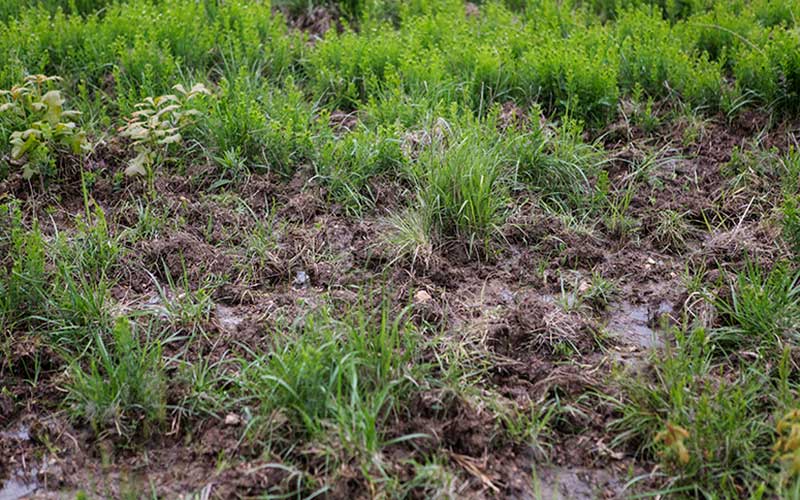
He made a note to send trappers out there as soon as possible.
He was still talking about that fresh damage when an enormous bald eagle swooped down from the sky and seemed to fill the windshield of McLain’s pickup. It flew at his truck and then over it.
The eagle eventually landed high atop a tree, maybe 50 yards ahead of the truck and 20 yards to the right. It was a thrilling moment, one that is only possible deep in the woods, far away from development. The eagle’s flight, plus the 9 deer he passed in about 20 minutes, served as a vivid reminder of the appeal of rural and wild Missouri.
It’s also the kind of moment that the feral hog problem threatens. With abundant state conservation land and national forests, southern Missouri has many popular destinations for outdoor enthusiasts. Some fear feral hogs will keep campers and hikers away.
The Ozark Trail runs more than 200 miles through southern Missouri. Hikers posting to the Ozark Trail Association’s discussion board have reported numerous sightings of feral hogs and the damage they leave behind.
Experts say feral hogs are wild animals and should be treated with great caution. Feral hogs can spread diseases such as swine brucellosis, pseudorabies, trichinosis, and leptospirosis to people, pets, wild animals, and livestock. “These hogs get aggressive. If you walk up on a big sow that’s got 8 or 10 nursing pigs, she will charge you,” Scaggs said. “It’s not going to be long before someone out here in our pristine wilderness has an encounter with one of these. When you get that reputation—that it’s not safe to go there because you don’t know if you’re going to encounter a wild hog on your hiking trip—it also has a long-term effect on the economy of the county.”
When he talks about feral hogs, McLain sounds like the curator at an art museum that has been targeted by vandals who sneak in at night and scribble on the walls. They haven’t defamed a painting yet, but it’s only a matter of time before they do.
There is no data to suggest any animal populations have been significantly impacted because of the feral hog problem. But that’s the logical conclusion. Feral hogs eat roots, worms, and acorns in competition with native animals; eventually those animals are going to be forced to move elsewhere to find food.
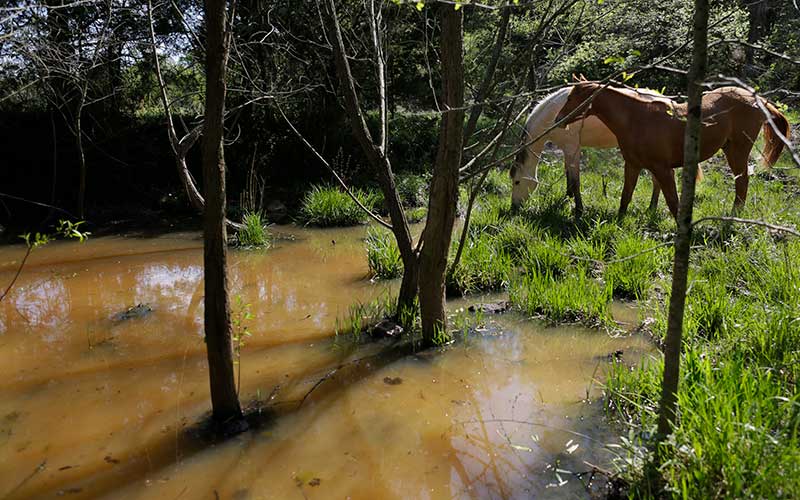
Plus, there is anecdotal evidence. Farmers who a few years ago had no feral hogs and abundant deer now tell McLain they have abundant feral hogs and few deer. It’s rare, but feral hogs have even killed and eaten fawns, in addition to reptiles, amphibians, and small mammals.
In 2015, the Missouri Feral Hog Partnership was formed, and in 2017, eleven state, local, and federal government agencies created the Strategic Hog Elimination Plan to completely eradicate feral hogs.
There is disagreement between government officials and some hunters about the best methods to get rid of the hogs, which live in groups called sounders of 10 to 60 animals. The Missouri Department of Conservation asks the public not to hunt hogs and instead advocates using traps, and only traps, to catch and kill large numbers at once. It is illegal to hunt feral hogs on lands owned or leased by the Department of Conservation. “The problem doesn’t just go away, it moves and multiplies and comes back,” McLain said. “This is why hog hunting won’t stop hog populations from growing and destroying more wildlife habitat, farms, and fields. Eliminating all feral hogs by trapping is the best way to stop feral hog damage.”
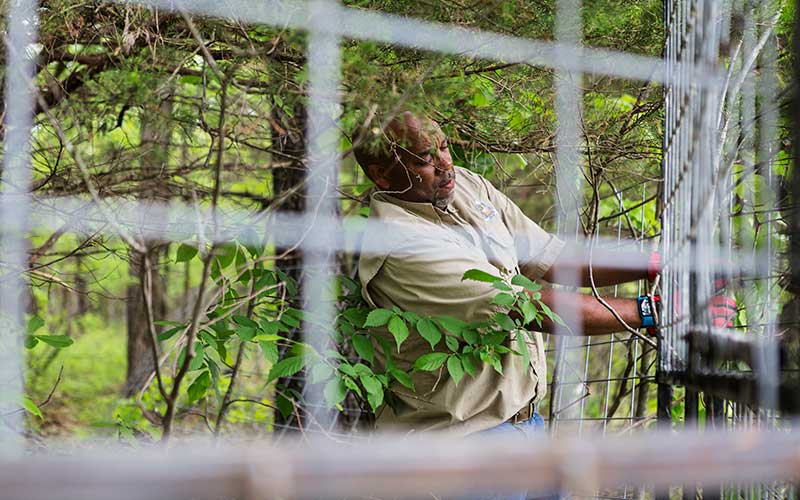
Some farmers and hunters, including Scaggs, believe the trapping-only approach is too narrow. They would rather use a multi-pronged attack—hunting, trapping, and whatever other methods will reduce the feral hog population. Even if hogs are killed only one by one, inefficient though that may be, they see each dead feral hog as one step closer to solving the problem.
Scaggs compares the feral hog problem to cancer. You don’t know how bad it is until you have it, and not every cancer responds the same way to the same treatment. “I’ll do whatever it takes on my farm, including trapping, hunting with dogs, and spotlighting.”
Part of what makes the feral hog infestation maddening is that many solutions create other problems. Scaggs has had some success with traps on his property, but the hogs have learned to avoid the traps.
“These hogs will move from food source to food source,” Scaggs said. “And you’ll have them there one day, and they won’t be back for a month. You think, ‘Oh boy, they’re gone.’ Then all of a sudden you get up and go back out, and they’ve destroyed the whole farm.”
State conservation officials say some hunters seem to be intentionally hurting the elimination efforts. At one trapping site, cameras showed regular visits from hogs. But video at the site showed a hunter used dogs to hunt there. That pushed back the trapping of hogs by three months because hogs are very sensitive to pressure from dogs, so they moved out of that area.
Elsewhere, trappers found a dog tied to a tree 100 yards from a trap. Not only did the dog’s presence render the trap useless, but the dog’s owner was trespassing while he hunted for hogs. “When someone trespasses onto an area where we’re trapping, and they chase the hogs, they may kill one or two from the group, but now they’ve scattered the rest of the group, sometimes for miles, impacting many new landowners,” McLain said.
The state touts the number of hogs trapped and killed—5,358 in 2016, 6,567 in 2017, and 9,365 in 2018—as proof that method is working. Others see those numbers not as proof that traps are effective but as proof that the population is still exploding—more hogs are being killed because there are more of them to kill.
Whatever disagreements exist on how to end the problem, there is uniform agreement that the feral hog problem is severe and that total eradication is the proper goal.
McLain parked in the woods and walked to a trap. The state uses several different kinds. Each performs the same function; it’s the details that are different. They all use corn as bait and trap the hogs in an enclosed space.
The one he visited looked like an animal pen. The circular wall was made of wire. A door above the opening was set to drop when hogs inside tripped the wire.
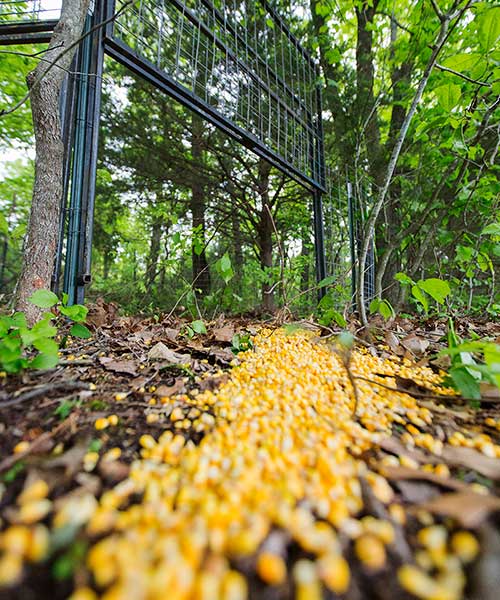
To set the trap, corn is spread in the shape of a U. Behind that U is another pile. Think of it like two feeding troughs. The animals are going to crowd around the first one before they go to the second one.
The U-shaped pile can accommodate a certain number of hogs, and once no more hogs can eat from that pile, the first hog that can’t fit its snout into the first pile will go to the second pile. In between the two piles is a trip wire. The first hog to go to the second pile will trip the wire on its way. (Only an adult hog would be big enough to trip the wire; a baby would walk under it.)
That’s exactly what happened one night last spring. The next day, McLain went to the trap and found 17 hogs in there—4 big ones and 13 little ones.
McLain was pleased to get that little bit closer to solving the problem. But as passionate as he is about eradicating feral hogs to preserve Missouri’s wildlands, he still feels a touch of ambivalence when he arrives at a trap full of animals.
Standing inside the trap, McLain talked about the unusual tension the attempt to eradicate feral hogs causes for conservation officers. It’s easy to describe the problems feral hogs cause. It’s easy to point to destroyed crops and wildlands. It’s not so easy to fix it when fixing it involves trapping and shooting thousands upon thousands of animals.
McLain has loved hunting and fishing and hiking in Missouri forests for his whole life. He taught his three children to love them, and he wants subsequent generations to have a chance to love them, too. McLain feels a duty to protect Missouri’s wildlands and return them to the way they were before feral hogs started damaging them.
Still, the whole endeavor can sound barbaric at first glance: “State conservation officers kill 9,365 animals” is not normally a sentence MDC officials would be pleased to utter. They got into that line of work to protect animals, not to kill them.
But McLain and his fellow officers see the evidence of feral hog destruction on farms and wildlands as incontrovertible: The feral hogs are endangering essentially every other animal that lives in Missouri’s wildlands and much of the plant life. Those animals and plants are native to this area. The feral hogs are not.
In that calculus, something has to give, and it’s the feral hogs.
“In the conservation department, we have those jobs where we wake up most mornings and say, ‘I can’t believe that I get paid to do what I’m going to do,’ ” McLain said. “We love it that much.”
He spends hours every week exploring the woods he loves so much. Complicated though it may be, eradicating hogs means more people will be able to enjoy the woods like he does. “I have a sense of doing something good for the natural resources,” he said.
That sense of doing good is focused on the long term. Neither McLain nor anyone else involved in the effort to eradicate feral hogs believe that the process will be easy or short.
Success will require years of effort. Nobody really knows how long. But McLain believes that with cooperation across the public and private sectors, the problem can eventually be solved.
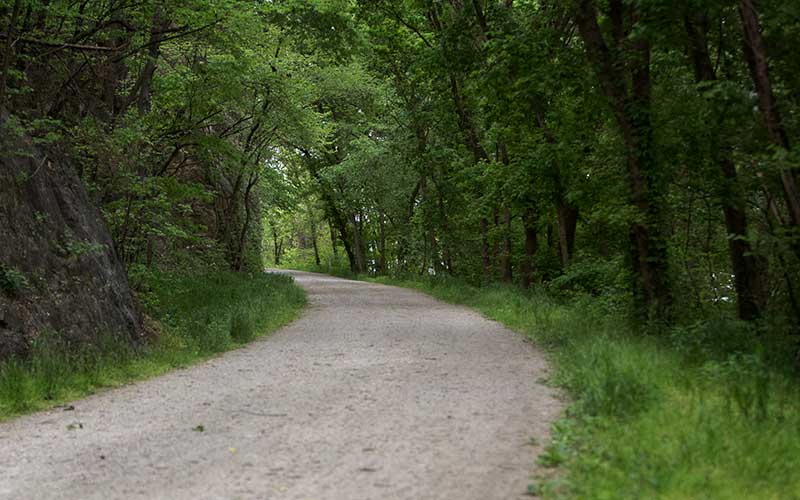
What to do if you spot evidence of feral hogs while hiking
If you see feral hogs while in the woods, experts advise you to keep a safe distance, especially if young animals are present.
Hogs in general carry dangerous diseases, and sows in particular are protective of their young. They have great senses of smell and hearing, so they likely will know you are present before you know they are. They will likely flee when they become aware of you.
If you encounter a sounder, take special care not to get in between the sows and the young. They might charge if they feel cornered or trapped.
The Missouri Department of Conservation asks that residents report all feral hog sightings or releases by visiting mdc.mo.gov/feralhog or by calling 573-522-4115 ext. 3296.
Related Posts
Inside Walt Disney’s Life in Marceline
Very little remains of the once massive cottonwood tree Walter Elias Disney called his “Dreaming Tree.” The coarse, woody debris is an anchor tying a small town in Missouri to the pioneer of the American entertainment industry.
Inside Jefferson City’s Museum of Modern Art
Opened in October 2015, the Jefferson City Museum of Modern Art features the works of Purvis Young, Thornton Dial, and Abdoulaye Diarrassouba, better known as Aboudia. All have earned national and international acclaim for their art, which can be found in some of the country’s most distinguished museums.
Inside the Newest Cafe & Bike Shop on the Katy Trail
Closely nuzzled against the Katy Trail in Rocheport, Meriwether Café & Bike Shop provides a quietly colorful experience. Managers Brandon and Whitney Vair transformed the building that used to house the Trailside Café into a bright spot set against the green-covered hills of Rocheport.

